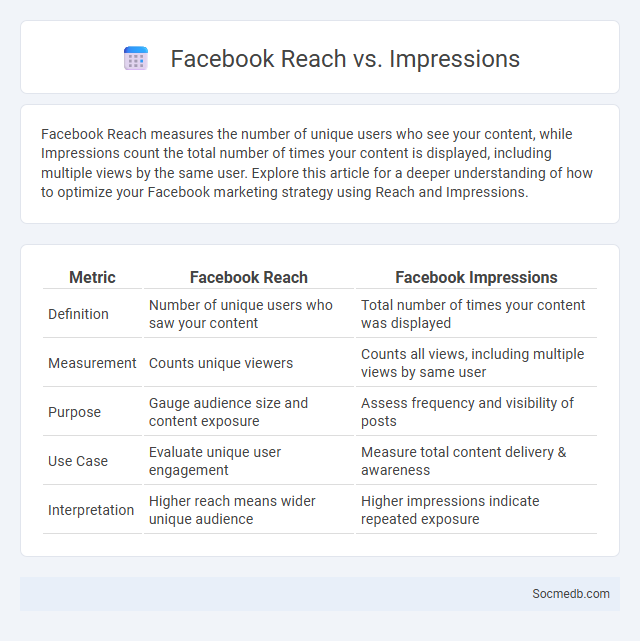
Photo illustration: Facebook Reach vs Impressions
Facebook Reach measures the number of unique users who see your content, while Impressions count the total number of times your content is displayed, including multiple views by the same user. Explore this article for a deeper understanding of how to optimize your Facebook marketing strategy using Reach and Impressions.
Table of Comparison
| Metric | Facebook Reach | Facebook Impressions |
|---|---|---|
| Definition | Number of unique users who saw your content | Total number of times your content was displayed |
| Measurement | Counts unique viewers | Counts all views, including multiple views by same user |
| Purpose | Gauge audience size and content exposure | Assess frequency and visibility of posts |
| Use Case | Evaluate unique user engagement | Measure total content delivery & awareness |
| Interpretation | Higher reach means wider unique audience | Higher impressions indicate repeated exposure |
Understanding Facebook Reach: Definition and Importance
Facebook Reach refers to the total number of unique users who see your content on the platform, providing a critical metric for measuring the effectiveness of your social media campaigns. Understanding your Facebook Reach helps optimize content strategies, improve engagement rates, and maximize brand visibility. By analyzing Reach data, you can tailor your posts to better connect with your target audience and grow your online presence.
What Are Facebook Impressions? Key Differences Explained
Facebook impressions refer to the total number of times a post or advertisement is displayed on users' screens, regardless of clicks or interactions. Unlike reach, which counts unique users who see the content, impressions can include multiple views by the same user, providing insight into content visibility and frequency. Understanding the difference between impressions and reach is crucial for optimizing ad performance and measuring campaign effectiveness on the platform.
Facebook Reporting: Tools and Metrics Overview
Facebook reporting tools provide detailed insights into page performance, audience engagement, and advertising effectiveness through metrics like reach, impressions, click-through rate (CTR), and conversion tracking. The Facebook Insights dashboard offers real-time data on follower demographics, post interactions, and video retention rates, enabling marketers to optimize content strategies. Advanced reporting features incorporate customizable reports and A/B testing results to measure campaign ROI and identify growth opportunities systematically.
Reach vs Impressions: Which Metric Matters More?
Reach measures the total number of unique users who have seen your content, providing insight into audience size and brand awareness. Impressions count the total number of times your content is displayed, indicating frequency and potential engagement opportunities. Marketers prioritize reach when aiming for broad exposure, while impressions are crucial for assessing content visibility and repetitive impact on target users.
How Facebook Calculates Reach and Impressions
Facebook calculates reach by counting the number of unique users who see a post, while impressions measure the total number of times the post is displayed, including multiple views by the same user. The platform uses algorithms that track user interactions, post visibility, and ad delivery settings to differentiate between organic and paid reach. Understanding these metrics helps marketers optimize content strategy and budget allocation for Facebook advertising campaigns.
Common Reporting Mistakes to Avoid
Common reporting mistakes on social media include misinterpreting engagement metrics, failing to track audience demographics accurately, and neglecting to set clear campaign goals. You should avoid relying solely on vanity metrics like likes or follower counts, as these do not fully capture the effectiveness of your social media strategy. Properly analyzing conversions, reach, and interaction quality ensures meaningful insights for optimizing future campaigns.
Maximizing Your Facebook Reach Strategically
Maximizing your Facebook reach strategically involves creating engaging content tailored to your target audience's interests and utilizing Facebook's algorithm to your advantage. Focus on posting consistently during peak activity times, leveraging Facebook Insights to analyze performance metrics and refine your approach. Incorporate a mix of multimedia, including videos and interactive posts, to boost visibility and encourage user interaction, ultimately enhancing your overall social media presence.
Improving Impressions for Better Facebook Performance
Maximizing your Facebook impressions requires a strategic blend of high-quality content, consistent posting schedules, and targeted audience engagement. Utilize Facebook Insights to analyze which types of posts generate the most interaction, then refine your content strategy accordingly to boost visibility. Your ability to improve impressions directly influences overall Facebook performance by increasing reach and fostering stronger community connections.
Analyzing Your Facebook Reports: Actionable Insights
Analyzing your Facebook reports provides key metrics such as engagement rates, audience demographics, and post reach, enabling data-driven decisions to optimize content strategy. Identifying top-performing posts helps refine targeting and increase user interaction by focusing on popular formats and topics. Monitoring trends in click-through rates and conversion metrics offers actionable insights to enhance advertising efficiency and boost overall ROI.
Best Practices for Accurate Facebook Measurement
Accurate Facebook measurement relies on implementing best practices such as setting up Facebook Pixel correctly, verifying domain ownership, and utilizing Conversion API to track user actions effectively. Regularly auditing data accuracy and excluding irrelevant traffic ensures your insights reflect genuine audience behavior. By optimizing these strategies, your social media campaigns can achieve more precise performance analysis and improved return on ad spend.
 socmedb.com
socmedb.com